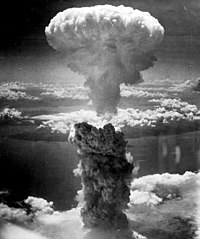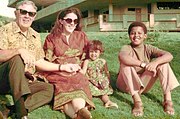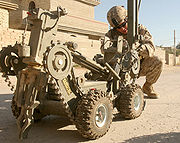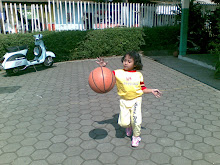Barack Obama
| Barack Obama | 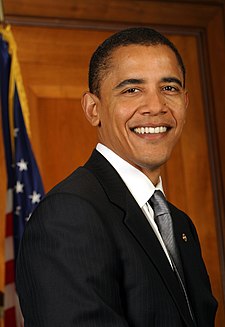
|
| Taking office
January 20, 2009 | | Vice President | Joe Biden (elect) | | Succeeding | George W. Bush |
| In office
January 4, 2005 – November 16, 2008 | | Preceded by | Peter Fitzgerald | | Succeeded by | TBD |
| In office
January 8, 1997 – November 4, 2004 | | Preceded by | Alice Palmer | | Succeeded by | Kwame Raoul |
| | Born | August 4, 1961 (1961-08-04) (age 47)
Honolulu, Hawaii, U.S.A. | | Birth name | Barack Hussein Obama II | | Political party | Democratic Party | | Spouse | Michelle Obama (m. 1992) | | Children | Malia Ann (b. 1998)
Sasha (b. 2001) | | Residence | Kenwood, Chicago, Illinois | | Alma mater | Columbia University
Harvard Law School | | Profession | Attorney
Politician | | Religion | United Church of Christ | | Signature |  | | Website | Office of the President-Elect | More detailed articles about Barack Obama
————————————
Early life and career · (Family · Memoir)
Illinois Senate career
U.S. Senate career
Presidential primaries · Obama–Biden 2008
Policy positions · Public image | |
Barack Hussein Obama II (pronounced /bəˈrɑːk hʊˈseɪn oʊˈbɑːmə/; born August 4, 1961) is the President-elect of the United States and the first African American to be elected President of the United States. Obama was the junior United States Senator from Illinois from 2005 until he resigned on November 16, 2008, following his election to the Presidency.
He is a graduate of Columbia University and Harvard Law School, where he was president of the Harvard Law Review. Obama worked as a community organizer and practiced as a civil rights attorney before serving three terms in the Illinois Senate from 1997 to 2004. He also taught constitutional law at the University of Chicago Law School from 1992 to 2004. Following an unsuccessful bid for a seat in the U.S. House of Representatives in 2000, he announced his campaign for the U.S. Senate in January 2003, won a primary victory in March 2004, and was elected to the Senate in November 2004. Obama delivered the keynote address at the Democratic National Convention in July 2004.
As a member of the Democratic minority in the 109th Congress, he helped create legislation to control conventional weapons and to promote greater public accountability in the use of federal funds. He also made official trips to Eastern Europe, the Middle East, and Africa. During the 110th Congress, he helped create legislation regarding lobbying and electoral fraud, climate change, nuclear terrorism, and care for returned U.S. military personnel.
Early life and career
Barack Obama was born at the Kapi'olani Medical Center for Women & Children in Honolulu, Hawaii,to Barack Obama, Sr., a Luo from Nyang’oma Kogelo, Nyanza Province, Kenya, and Ann Dunham, a white American from Wichita, Kansas of mainly English, Irish and smaller amounts of German descent.His parents met in 1960 while attending the University of Hawaii at Manoa, where his father was a foreign student.The couple married February 2, 1961; they separated when Obama was two years old and subsequently divorced in 1964.Obama's father returned to Kenya and saw his son only once more before dying in an automobile accident in 1982.
After her divorce, Dunham married Lolo Soetoro, and the family moved to Soetoro's home country of Indonesia in 1967, where Obama attended local schools, such as Asisi, in Jakarta until he was ten years old. He then returned to Honolulu to live with his maternal grandparents, Madelyn and Stanley Dunham, while attending Punahou School from the fifth grade in 1971 until his graduation from high school in 1979. Obama's mother returned to Hawaii in 1972 for several years, and then in 1977 went back to Indonesia, where she worked as an anthropological field worker. She stayed there most of the rest of her life, returning to Hawaii in 1994. She died of ovarian cancer in 1995.
As an adult Obama admitted that he used marijuana, cocaine, and alcohol when in high school, which he described as his greatest moral failure at the 2008 Civil Forum on the Presidency.
Following high school, Obama moved to Los Angeles, where he studied at Occidental College for two years.He then transferred to Columbia University in New York City, where he majored in political science with a specialization in international relations.Obama graduated with a B.A. from Columbia in 1983, then at the start of the following year worked for a year at the Business International Corporation and then at the New York Public Interest Research Group.
After four years in New York City, Obama moved to Chicago, where he was hired as director of the Developing Communities Project (DCP), a church-based community organization originally comprising eight Catholic parishes in Greater Roseland (Roseland, West Pullman, and Riverdale) on Chicago's far South Side, and worked there for three years from June 1985 to May 1988. During his three years as the DCP's director, its staff grew from one to thirteen and its annual budget grew from $70,000 to $400,000, with accomplishments including helping set up a job training program, a college preparatory tutoring program, and a tenants' rights organization in Altgeld Gardens.Obama also worked as a consultant and instructor for the Gamaliel Foundation, a community organizing institute. In mid-1988, he traveled for the first time to Europe for three weeks and then for five weeks in Kenya, where he met many of his Kenyan relatives for the first time.
Obama entered Harvard Law School in late 1988. At the end of his first year, he was selected, based on his grades and a writing competition, as an editor of the Harvard Law Review.In February 1990, in his second year, he was elected president of the Law Review, a full-time volunteer position functioning as editor-in-chief and supervising the Law Review's staff of eighty editors. Obama's election as the first black president of the Law Review was widely reported and followed by several long, detailed profiles.During his summers, he returned to Chicago where he worked as a summer associate at the law firms of Sidley & Austin in 1989 and Hopkins & Sutter in 1990. After graduating with a Juris Doctor (J.D.) magna cum laude from Harvard in 1991, he returned to Chicago.
The publicity from his election as the first black president of the Harvard Law Review led to a publishing contract and advance for a book about race relations.In an effort to recruit him to their faculty, the University of Chicago Law School provided Obama with a fellowship and an office to work on his book.He originally planned to finish the book in one year, but it took much longer as the book evolved into a personal memoir. In order to work without interruptions, Obama and his wife, Michelle, traveled to Bali where he wrote for several months. The manuscript was finally published in mid-1995 as Dreams from My Father.
Obama directed Illinois' Project Vote from April to October 1992, a voter registration drive with a staff of ten and seven hundred volunteers; it achieved its goal of registering 150,000 of 400,000 unregistered African Americans in the state, and led to Crain's Chicago Business naming Obama to its 1993 list of "40 under Forty" powers to be.
Obama served for twelve years as a professor at the University of Chicago Law School, teaching constitutional law. He was first classified as a Lecturer from 1992 to 1996, and then as a Senior Lecturer from 1996 to 2004.He also joined Davis, Miner, Barnhill & Galland, a twelve-attorney law firm specializing in civil rights litigation and neighborhood economic development, where he was an associate for three years from 1993 to 1996, then of counsel from 1996 to 2004, with his law license becoming inactive in 2002.
Obama was a founding member of the board of directors of Public Allies in 1992, resigning before his wife, Michelle, became the founding executive director of Public Allies Chicago in early 1993. He served from 1994 to 2002 on the board of directors of the Woods Fund of Chicago, which in 1985 had been the first foundation to fund the Developing Communities Project, and also from 1994 to 2002 on the board of directors of The Joyce Foundation. Obama served on the board of directors of the Chicago Annenberg Challenge from 1995 to 2002, as founding president and chairman of the board of directors from 1995 to 1999. He also served on the board of directors of the Chicago Lawyers' Committee for Civil Rights Under Law, the Center for Neighborhood Technology, and the Lugenia Burns Hope Center.







